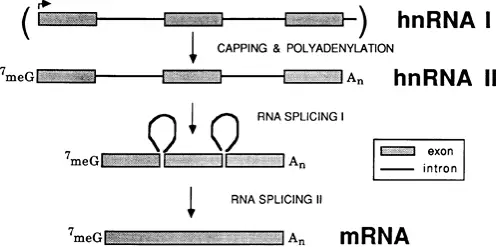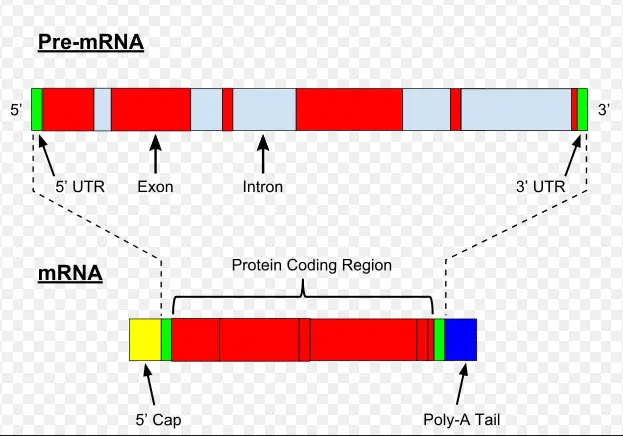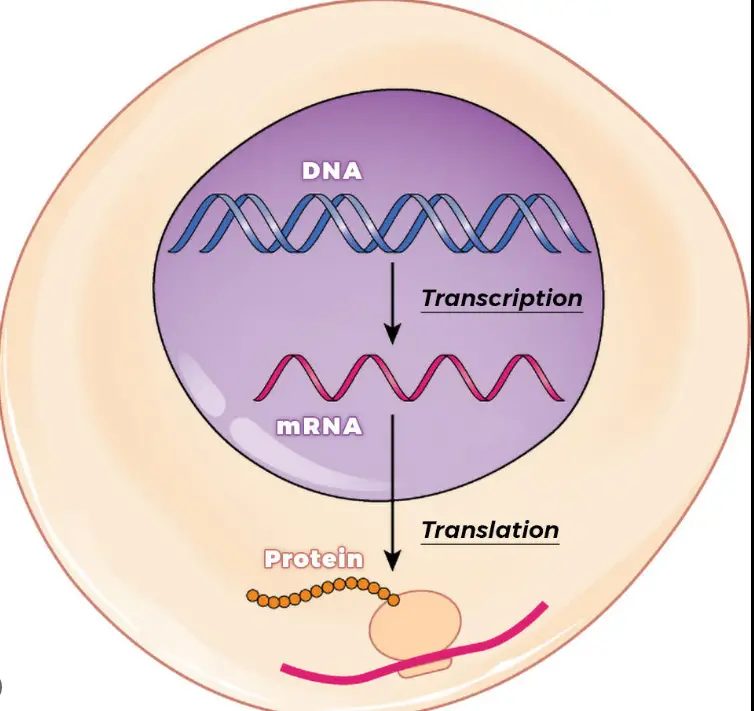Ribonucleic acid (RNA) is a pivotal molecule in the realm of genetics, playing various crucial roles in the processing and functioning of genetic information. RNA is primarily responsible for the synthesis of proteins in living cells, a fundamental process for life. Among the different types of RNA, heteronuclear RNA (hnRNA) and messenger RNA (mRNA) are particularly significant due to their direct involvement in the gene expression pathway.
hnRNA and mRNA are both crucial in the gene expression process but serve different roles and undergo different processing steps. hnRNA is the initial transcript from DNA, which includes introns and exons. This precursor mRNA is then processed into mature mRNA by splicing out the introns and joining the exons together. The mature mRNA serves as a template for protein synthesis during translation.
While both types of RNA originate from DNA and are vital for synthesizing proteins, their differences lie in their form and function within the cell. hnRNA is the nascent form found within the nucleus and includes unmodified genetic sequences, whereas mRNA represents the processed, mature form that exits the nucleus to guide protein synthesis in the cytoplasm.

RNA Basics
What is RNA?
RNA, or Ribonucleic Acid, is a vital molecule within biological systems that carries genetic instructions from DNA to control the synthesis of proteins. Unlike DNA, RNA is usually single-stranded and plays multiple roles in the cell, including acting as a messenger, regulator, and catalyst in various biochemical processes. Its ability to fold into complex three-dimensional shapes allows it to bind with other molecules and perform its functions effectively.
Role in Genetic Expression
RNA is central to the process of genetic expression, which involves the conversion of genetic code into the proteins necessary for cellular function. This process occurs in two main stages: transcription and translation. During transcription, RNA polymerase reads DNA sequences and synthesizes RNA. This RNA then serves as a template during translation, guiding the assembly of amino acids into proteins. This fundamental role makes RNA essential for the growth, reproduction, and maintenance of all living organisms.
What is hnRNA?
Definition and Origin
Heterogeneous nuclear RNA (hnRNA) is the primary form of RNA synthesized from DNA in the nucleus of eukaryotic cells. It includes both exons (coding regions) and introns (non-coding regions). hnRNA is considered the precursor to messenger RNA (mRNA), which is the form that eventually participates in protein synthesis.
hnRNA Structure
hnRNA molecules are complex structures that initially mirror the DNA from which they are transcribed. They are large, varied in size, and typically coiled. The presence of both introns and exons is a significant characteristic, and they often have a variety of proteins bound to them, which play roles in RNA processing. The processing includes capping, polyadenylation, and splicing, which transform hnRNA into mRNA.
What is mRNA?
Definition and Process
Messenger RNA (mRNA) is formed from the processing of hnRNA and serves as a direct template for protein synthesis in cells. The creation of mRNA involves editing the initial hnRNA transcript by removing introns and joining exons in a process known as splicing. Once mature, mRNA leaves the nucleus and travels to the ribosome, where it provides the coded instructions for assembling amino acids into proteins.
mRNA Structure
mRNA is characterized by its single-stranded nature and typically shorter length compared to hnRNA. It includes a 5′ cap and a poly-A tail, which are not found in hnRNA. These additions help protect mRNA from degradation and assist in the initiation of translation. The structure of mRNA is critical for its function, as it needs to be both stable enough to survive in the cytoplasm and flexible enough to be read by the ribosome during protein synthesis.
Key Differences
Transcription Processes
The transcription of hnRNA and mRNA involves distinct processes that reflect their roles in the cell. hnRNA transcription includes the copying of both introns and exons from DNA, and it occurs entirely within the nucleus. In contrast, the transcription of mRNA is actually the process of modifying hnRNA, involving the removal of introns and the addition of a cap and tail.
Post-Transcription Modifications
hnRNA undergoes several post-transcription modifications before it becomes mRNA. These modifications include:
- Capping: A modified guanine nucleotide is added to the 5′ end of the hnRNA.
- Polyadenylation: A tail of adenine bases is added to the 3′ end.
- Splicing: Introns are removed, and exons are joined together.
These changes are critical for transforming the precursor hnRNA into a molecule that can be exported from the nucleus and translated into protein.
Function in Cells
While both hnRNA and mRNA are essential for gene expression, their functions in the cell are distinct. hnRNA serves as a transient intermediary, holding the genetic blueprint until it can be refined into the final mRNA product. In contrast, mRNA has the specific role of conveying this genetic information to the ribosomes, where it is translated into proteins that perform various functions within the cell, from structural support to catalyzing biochemical reactions.

Synthesis and Processing
hnRNA to mRNA Conversion
The transformation of hnRNA to mRNA is a critical process in the cell, allowing the genetic code to be effectively used for protein synthesis. This conversion is a multi-step procedure that refines the initial hnRNA transcript into a more streamlined and functional mRNA. The main steps involved include:
- Splicing: This is the process where introns are cut out and exons are stitched together.
- 5′ Capping: The addition of a cap to the 5′ end of the RNA molecule, which is crucial for stability and later attachment to the ribosome.
- 3′ Polyadenylation: Adding a tail of adenine bases to the 3′ end of the RNA, enhancing its stability and transport out of the nucleus.
Enzymes and Factors Involved
Several key enzymes and protein factors are involved in the hnRNA to mRNA processing. These include:
- RNA Polymerase II: This enzyme is responsible for transcribing hnRNA from DNA.
- Spliceosomes: Complexes of proteins and RNA that carry out splicing.
- Capping Enzymes: These attach the 5′ cap to the hnRNA.
- Poly(A) Polymerase: An enzyme that adds the poly-A tail at the 3′ end.
Biological Functions
hnRNA Functions
hnRNA plays several roles in the cell, primarily related to its position as the precursor to mRNA:
- Gene Regulation: The processing of hnRNA allows for the regulation of gene expression, as not all hnRNA transcripts become mRNA.
- Nuclear Processing Indicator: The state of hnRNA can serve as an indicator of how genetic processing is functioning within the nucleus.
mRNA Functions
The functions of mRNA are directly tied to protein synthesis:
- Protein Coding: mRNA provides the blueprint for constructing proteins through the sequence of nucleotides that encode amino acids.
- Regulation of Gene Expression: The availability and degradation of mRNA influence which proteins are produced and in what quantities.
Practical Applications
Research and Medicine
Understanding the nuances of hnRNA and mRNA has vast implications in research and medicine. For instance:
- Disease Diagnosis: Abnormalities in mRNA processing can indicate diseases like cancer. Researchers can analyze mRNA levels for early diagnosis or the progression of disease.
- Targeted Therapies: Drugs can be designed to modulate mRNA levels or function, offering new treatments for genetic disorders.
Genetic Engineering
The ability to manipulate mRNA is fundamental in genetic engineering. Techniques include:
- CRISPR-Cas9: This technology can be used to edit genes at the mRNA level, potentially correcting genetic defects before they are translated into proteins.
- Synthetic Biology: Scientists can create synthetic mRNA to instruct cells to produce beneficial proteins.
Frequently Asked Questions
What is hnRNA?
Heterogeneous nuclear RNA (hnRNA) is the initial raw transcript produced from DNA, found in the nucleus of eukaryotic cells. It contains both introns and exons and requires processing to become mRNA, which can then be used for protein synthesis.
How is mRNA processed from hnRNA?
mRNA is created from hnRNA through a process called splicing, where introns are removed and exons are joined together. This processing also includes the addition of a 5′ cap and a 3′ poly-A tail, which are crucial for the mRNA’s stability and its recognition during protein synthesis.
What roles do hnRNA and mRNA play in cells?
hnRNA is primarily involved in the transcription stage of gene expression, serving as a precursor to mRNA. mRNA’s role is critical in translation, where it provides the code that directs the synthesis of proteins, based on the genetic instructions carried from the DNA.
How do hnRNA and mRNA differ structurally?
hnRNA is generally larger and includes both introns and exons. After processing, mRNA is smaller, consisting only of exons, and includes modifications like a 5′ cap and a poly-A tail, which are not present in hnRNA.
Conclusion
The distinction between hnRNA and mRNA is a fundamental concept in molecular biology that enhances our understanding of genetic expression and protein synthesis. These molecules, though similar in origin, undergo distinct modifications that equip them for specific roles within the cell. Their study not only sheds light on the intricate processes of life at a molecular level but also provides crucial insights that drive advancements in genetic research and medical therapies.
Exploring these differences not only clarifies the stages of gene expression but also underscores the complexity and precision of cellular mechanisms. This knowledge is vital for biotechnological applications and the development of genetic-based treatments, illustrating the deep interconnectedness of structure and function in biological systems.

